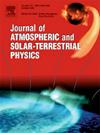Spatial and temporal dynamics of solar energy resources in China and forecast of future solar radiation
IF 1.9
4区 地球科学
Q3 GEOCHEMISTRY & GEOPHYSICS
Journal of Atmospheric and Solar-Terrestrial Physics
Pub Date : 2025-02-12
DOI:10.1016/j.jastp.2025.106463
引用次数: 0
Abstract
Solar radiation exhibits significant temporal fluctuations due to the influence of atmospheric water vapor, aerosols, haze, etc. It is crucial to analyze the temporal pattern of change and future distribution of solar energy resources for optimize their utilization and facilitate their development. Consequently, this study analyzes solar radiation data from 1994 meteorological stations, identifying complex trends and using sudden change tests to predict the annual and seasonal distributions of solar radiation in China over the next five or ten years. The results indicate a declining trend in global solar radiation across most of China, with an average annual decrease of −4.26 MJ/m2/y. The annual variation in diffuse solar radiation demonstrates an upward trajectory, with an average increase of 0.34 MJ/m2/y. For the next 5 and 10 years, global solar radiation values are estimated to range from 3020 to 6840 MJ/m2 and from 2970 to 6940 MJ/m2, respectively. The spatial distribution exhibits higher in the west and north, and lower in the east and south. The annual diffuse solar radiation values for the next five and ten years are estimated to range from 650 to 3060 MJ/m2 and 680–3120 MJ/m2, respectively, exhibiting an increasing trend from north to south.
中国太阳能资源时空动态及未来太阳辐射预测
由于大气水汽、气溶胶、雾霾等的影响,太阳辐射表现出明显的时间波动。分析太阳能资源变化的时间格局和未来分布对优化利用和促进太阳能资源的开发至关重要。因此,本研究分析了1994年气象站的太阳辐射数据,确定了复杂的趋势,并利用突变试验预测了未来5年或10年中国太阳辐射的年和季节分布。结果表明,中国大部分地区太阳总辐射呈下降趋势,年平均减少- 4.26 MJ/m2/y。太阳漫射辐射的年变化呈上升趋势,平均增加0.34 MJ/m2/y。未来5年和10年,估计太阳总辐射值分别在3020 - 6840 MJ/m2和2970 - 6940 MJ/m2之间。空间分布呈西、北高、东、南低的趋势。估计未来5年和10年的年漫射辐射值分别在650 ~ 3060 MJ/m2和680 ~ 3120 MJ/m2之间,呈现自北向南增加的趋势。
本文章由计算机程序翻译,如有差异,请以英文原文为准。
求助全文
约1分钟内获得全文
求助全文
来源期刊

Journal of Atmospheric and Solar-Terrestrial Physics
地学-地球化学与地球物理
CiteScore
4.10
自引率
5.30%
发文量
95
审稿时长
6 months
期刊介绍:
The Journal of Atmospheric and Solar-Terrestrial Physics (JASTP) is an international journal concerned with the inter-disciplinary science of the Earth''s atmospheric and space environment, especially the highly varied and highly variable physical phenomena that occur in this natural laboratory and the processes that couple them.
The journal covers the physical processes operating in the troposphere, stratosphere, mesosphere, thermosphere, ionosphere, magnetosphere, the Sun, interplanetary medium, and heliosphere. Phenomena occurring in other "spheres", solar influences on climate, and supporting laboratory measurements are also considered. The journal deals especially with the coupling between the different regions.
Solar flares, coronal mass ejections, and other energetic events on the Sun create interesting and important perturbations in the near-Earth space environment. The physics of such "space weather" is central to the Journal of Atmospheric and Solar-Terrestrial Physics and the journal welcomes papers that lead in the direction of a predictive understanding of the coupled system. Regarding the upper atmosphere, the subjects of aeronomy, geomagnetism and geoelectricity, auroral phenomena, radio wave propagation, and plasma instabilities, are examples within the broad field of solar-terrestrial physics which emphasise the energy exchange between the solar wind, the magnetospheric and ionospheric plasmas, and the neutral gas. In the lower atmosphere, topics covered range from mesoscale to global scale dynamics, to atmospheric electricity, lightning and its effects, and to anthropogenic changes.
 求助内容:
求助内容: 应助结果提醒方式:
应助结果提醒方式:


